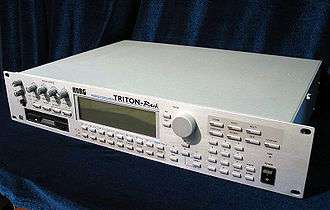Sound module

A sound module is an electronic musical instrument without a human-playable interface such as a keyboard. Sound modules have to be operated using an externally connected device, which is often a MIDI controller, of which the most common type is the musical keyboard (although wind controllers and guitar controllers are also used). Controllers are devices that provides the human-playable interface and may or may not produce sounds of its own. Another common way of controlling a sound module is through a sequencer, which is computer hardware or software designed to record and play back control information for sound generating hardware. Connections between sound modules, controllers, and sequencers are generally made with MIDI (Musical Instrument Digital Interface), which is a standardized protocol designed for this purpose.
Sound modules may use any number of technologies to produce their sounds.A sound module may be a synthesizer, a sampler, or a rompler. Drum modules are sound modules which specialize in percussion sounds. Drum modules may be triggered by external trigger pads or pickups as well as through MIDI. Drum modules are distinguished from drum machines through their lack of dedicated on-board triggers and lack of an integrated sequencer. Sound modules are often rack-mountable, but might also have a table-top form factor. The height of a sound module is often described in U or unit. Small sound modules are mostly 1U in height, the larger models a multiplication e.g. 2U or 3U.
Because most electronic instruments are designed in a modularized way, manufacturers often release a sound module version of their fully integrated instruments. A sound module may have all the other features of the controller-equipped version, but it often has a smaller display or limited programming controls. In this case, sounds can be loaded through MIDI or external media. In some cases, sound modules have expanded capacity for sounds in comparison to the controller-equipped version. In the 2010s, hardware sound modules have largely been replaced with software equivalents, due to the increased speed and processing power of computers and their decrease in price. Nevertheless, some DJs and EDM musicians continue to use vintage 1980s sound modules for their unique sound.
Terminology
A sound module may also be referred to as "tone generator", "synth module", "MIDI sound generator" or "rack-mount synthesizer".
Advantages
A sound module has the same advantages over a fully integrated instrument as does any system with a modularized design:
- Cost — a sound module is cheaper than a comparable instrument equipped with a controller
- Space — a sound module takes up less room than an instrument equipped with a controller
- Expandability — many sound modules can be expanded with sounds and memory
- Troubleshooting – if a sound module develops problems, just this one unit can be removed for repair or replacement, leaving the rest of a keyboard player's rig the same.
- Obsolescence cycles — when it becomes obsolete, a sound module can be replaced without changing a favorite controller, or vice versa.
Notable examples
- Roland MKS20, Piano sound module used by many acts in the 80s to early 90s. Based on engine from RD1000.
- Yamaha TX16W (1988), sound module with an ability to boot OS from diskette; known particularly well for having a third-party OS codenamed Typhoon 2000 by NuEdge Development, a group of hackers who were dissatisfied with original OS.
- Roland Sound Canvas series (1991), first sound module to implement General MIDI standard with GS extensions.
Difference from audio interfaces
Audio interfaces are often erroneously called sound modules. The audio interface connects a computer to other devices; and software in the computer actually generates sound using samples or synthesis. The functionality of the computer and I/O device plus the software is a superset of a traditional sound module.